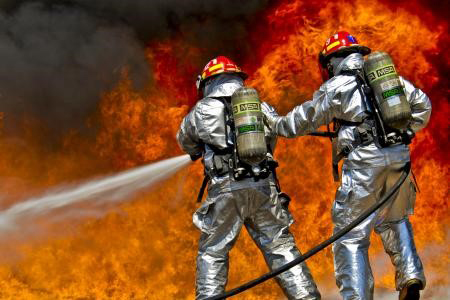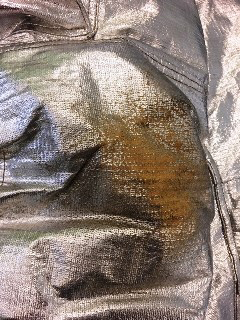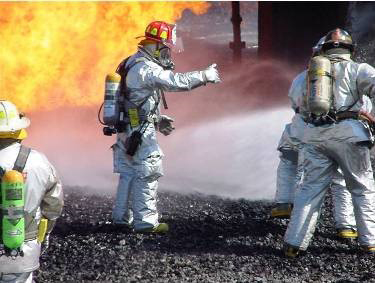
Many civilian airport fire chiefs are struggling to fund their operating budgets, and personal protective equipment (PPE) in the industry is one of those line items that must be funded. The Federal Aviation Administration (FAA) inspects all Part 139 airport fire departments annually, and one of the highly scrutinized areas of the inspection is firefighter PPE. The traditional industry standard is that ARFF proximity turnout gear is costly to purchase, the service life of the garment is only five years, and the maintenance costs are higher than structural gear. One of the biggest complaints ARFF chiefs have is the incidental wear and damage with proximity gear. Firefighting is a physically demanding job and requires a firefighter to kneel or crawl low on the floor to avoid high heat conditions. The aluminized outer shell of the ARFF PPE is susceptible to being worn off or torn, making the garment noncompliant with FAA inspectors.

The Standard
FAR 139.319 (i) (1) states that “All rescue and firefighting personnel are equipped in a manner authorized by the Administrator with protective clothing and equipment needed to perform their duties.” The terminology “Authorized by the Administrator” is a reference to the FAA Advisory Circular or (AC). The specific AC 150/5210-14B, Aircraft Rescue Firefighting Equipment, Tools, and Clothing adopts NFPA 1971, Standard on Protective Ensembles for Structural Firefighting and Proximity Firefighting, which is a nationally recognized document on firefighter PPE. Therefore, the authority having jurisdiction (AHJ) has the ability to choose from the two types of firefighting protective ensembles that NFPA 1971 governs.
This risk assessment article is based on a modern fire apparatus design and extinguishing capabilities with modern technology vs. the limitations of the self-contained breathing apparatus (SCBA).

It is our opinion that the civilian airport fire department that provides ARFF protection services to a given airport should provide all firefighters with NFPA 1971 compliant structural firefighting gear in lieu of proximity gear. The evidence to support this change in PPE level, from traditional proximity gear to structural turn out gear, includes that most airport fire departments operate modern FAA-approved and funded ARFF response vehicles. These modernized ARFF vehicles can quickly knock down and extinguish large volumes of aviation or jet fuel fires, and some can even initiate interior fire attack with a piercing nozzle. Modern apparatus design, capabilities, and features have changed the dynamics of fireground strategy and tactics. These vehicles are also capable of applying large volumes of class B firefighting foam. The rapid delivery of foam has significantly afforded greater fire extinguishing capabilities. Firefighters that operate these vehicles have been trained on proper apparatus use, including all of the fire suppression systems: water, foam, halon, dry chemical, and/or the combined hydrochemical systems.
NFPA 1971 compliant structural firefighting gear has thermal insult protection levels to adequately protect ARFF firefighters post ARFF apparatus deployment and extinguishment. Firefighters operating a hoseline post ARFF apparatus operation will be protected at a minimum of +/-500°F for five minutes with no direct flame contact.
During any risk assessment, the PPE ensemble needs to be a matched level of protection. For example, proximity firefighting gear does indeed provide a higher level of thermal insult protection—+/-900°F for five minutes with no direct flame contact, but the weakest link of the firefighter’s personal protective ensemble would be the SCBA.
NFPA 1981, Standard on Open-Circuit Self-Contained Breathing Apparatus (SCBA) for Emergency Services, is an adopted best practice standard for providing firefighters with respiratory protection from high levels of heat, smoke, and toxic gases. The weakest link of the SCBA, in relation to thermal insult factors involving ARFF regardless of SCBA manufacturer, is the material used to create the firefighter’s SCBA face piece lens (polycarbonate). This material starts to incur thermal degradation at +/-300°F. Firefighters wearing proximity firefighting gear may never feel early indications of the thermal insult or temperatures at which the SCBA face piece may experience lens degradation or failure because the gear itself has a much higher level of thermal protective performance (TPP) than the SCBA face piece. Therefore, firefighters are more susceptible to receiving a respiratory injury and/or death because of the lack of matched protection factors of the overall personal protection ensemble.
Benefits of the PPE Change
- The structural firefighting protective ensemble costs less to purchase vs. proximity gear.
- NFPA 1971 differences in service life: five years for proximity firefighting gear vs. 10 years for structural firefighting gear.
- Structural firefighting gear has greater abrasion resistance.
- Structural firefighting gear maintenance will match current adopted policies.
- Structural firefighting gear is more flexible; has greater breathability; and traps less heat on the firefighter user, thus reducing firefighter heat stress (core temperature medical related emergencies).
- Mixed use of structural and proximity firefighter protective gear can be dangerous for the structural firefighter. Proximity gear works by reflecting radiant and convected energy. Firefighters wearing structural gear in close range of a firefighter wearing proximity gear will suffer a greater thermal injury because structural firefighter gear’s designed feature of absorbing energy.

Conclusion
ARFF fire chiefs and airport operations managers must establish a risk assessment for firefighter personal protection ensembles. We recommend that the AHJ authorize and adopt the NFPA 1971 standard for using structural firefighting protective gear at all aircraft emergencies based on the U.S. Department of Labor letter dated 1 July 2014, which references NFPA 1851. Best practices for your department should include a written IAP for large aviation or jet fuel fires. The plan should dictate by policy that primary fire suppression efforts at large fires that produce and exceed firefighters’ PPE and SCBA thermal protection be suppressed by the authorized ARFF apparatus, that supports the safety mission at your airport prior to any firefighter leaving the apparatus to engage in handline firefighting operations.
WILLIAM GREENWOOD is a 25-year veteran of the fire service. He is currently the assistant fire chief of training at the Manchester-Boston Regional Airport. Bill is a senior staff instructor for the New Hampshire Fire Academy and owns FETC Services, which provides advanced firefighter and leadership training/consultation services. He is also a national speaker for FDIC International and has been published in Fire Engineering and Fire Rescue.

